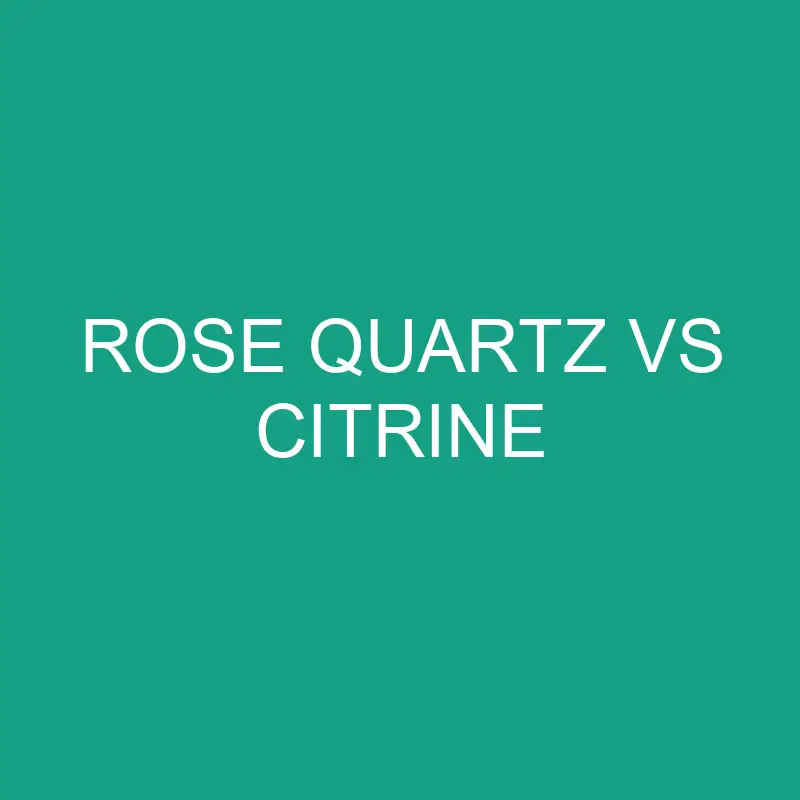A Delicate Embrace vs. Radiant Warmth
In the enchanting world of gemstones, the hues of rose and warm golden tones evoke a sense of beauty, warmth, and positive energy. Among the multitude of gems, Rose Quartz and Citrine stand out as representatives of these delightful colors, each with its unique attributes, historical significance, and metaphysical properties. In this exploration, we’ll delve into the gentle elegance of Rose Quartz and the radiant warmth of Citrine, unveiling the distinctive qualities that make them cherished gemstones.
Post Contents
Rose Quartz: The Gentle Embrace of Pink Serenity
Origins and Geological Background:
- Composition: Rose Quartz is a variety of quartz known for its delicate pink to rose-red color. The color comes from traces of titanium, iron, or manganese.
- Formation: It is often found in granite and pegmatite formations, forming as large masses or in coarse-grained rocks.
Physical Properties:
- Color and Appearance: Rose Quartz exhibits a range of pink hues, from pale pink to deeper rose tones. It is often translucent to transparent, with a vitreous luster.
- Transparency: Typically transparent to translucent.
- Crystal Structure: As a variety of quartz, Rose Quartz has a hexagonal crystal structure.
- Hardness: On the Mohs scale, it has a hardness of 7.
Origins and Mining:
- Locations: Rose Quartz is found in various locations worldwide, including Brazil, Madagascar, South Africa, and the United States.
- Mining: Extracted through mining operations, Rose Quartz is used for both jewelry and carvings.
Metaphysical Properties:
- Love and Compassion: Rose Quartz is often associated with love, compassion, and emotional healing. It is believed to open the heart chakra and encourage feelings of self-love and empathy.
- Calming Energy: The gem is known for its calming energy, helping to soothe emotions and promote inner peace.
- Relationship Harmony: Rose Quartz is often considered a stone of romance and is associated with fostering harmonious relationships.
Uses in Jewelry and Art:
- Jewelry: Rose Quartz is widely used in various forms of jewelry, including rings, necklaces, and earrings. It is often cut into cabochons or beads to showcase its soft pink hues.
- Carvings and Decorative Items: Larger specimens of Rose Quartz are carved into decorative items, figurines, and sculptures.
Citrine: The Radiant Glow of Golden Joy
Origins and Geological Background:
- Composition: Citrine is a variety of quartz known for its warm golden to yellow hues. The color comes from traces of iron in the crystal.
- Formation: It is often found in igneous rocks and can be created through the heat treatment of amethyst or smoky quartz.
Physical Properties:
- Color and Appearance: Citrine ranges from pale yellow to deep golden hues, often with a transparent or translucent quality. It has a vitreous luster.
- Transparency: Typically transparent to translucent.
- Crystal Structure: Like other quartz varieties, Citrine has a hexagonal crystal structure.
- Hardness: On the Mohs scale, Citrine has a hardness of 7.
Origins and Mining:
- Locations: Citrine is found in various locations, including Brazil, Spain, Russia, and the United States.
- Mining: Extracted through mining operations, Citrine is a popular gemstone for use in jewelry.
Metaphysical Properties:
- Abundance and Prosperity: Citrine is often associated with abundance, prosperity, and positive energy. It is believed to attract success and wealth.
- Joyful Energy: The gem is known for its joyful energy, promoting a positive outlook and dispelling negativity.
- Solar Plexus Activation: Citrine is linked to the solar plexus chakra, associated with personal power and confidence.
Uses in Jewelry and Art:
- Jewelry: Citrine is highly prized for its warm golden hues and is used in a variety of jewelry pieces, including rings, bracelets, and pendants. It is often faceted to maximize its brilliance.
- Carvings and Sculptures: Citrine is occasionally carved into decorative items and sculptures, showcasing its vibrant color.
Comparative Analysis: Rose Quartz vs. Citrine
1. Color Range:
- Rose Quartz: Exhibits delicate pink to rose-red hues.
- Citrine: Displays warm golden to yellow hues.
2. Transparency:
- Rose Quartz: Typically transparent to translucent.
- Citrine: Generally transparent to translucent.
3. Crystal Structure:
- Rose Quartz: Hexagonal crystal structure, characteristic of quartz.
- Citrine: Shares the hexagonal crystal structure with other quartz varieties.
4. Chakra Association:
- Rose Quartz: Linked to the heart chakra, associated with love and compassion.
- Citrine: Linked to the solar plexus chakra, associated with personal power and confidence.
5. Hardness:
- Rose Quartz: Has a hardness of 7 on the Mohs scale.
- Citrine: Also has a hardness of 7 on the Mohs scale.
6. Locations:
- Rose Quartz: Found in locations such as Brazil, Madagascar, South Africa, and the United States.
- Citrine: Found in various locations, including Brazil, Spain, Russia, and the United States.
7. Metaphysical Properties:
- Rose Quartz: Associated with love, compassion, and emotional healing.
- Citrine: Associated with abundance, prosperity, and positive energy.
8. Uses in Art:
- Rose Quartz: Carved into decorative items and sculptures.
- Citrine: Occasionally carved into decorative items, highly prized in faceted gemstone form for jewelry.
Conclusion: Choosing the Radiance for You
In the delightful dance of gemstones, Rose Quartz and Citrine offer distinct energies and aesthetics. While Rose Quartz gently embraces with its soft pink serenity, promoting love and emotional healing, Citrine radiates warmth and joy, attracting abundance and positive energy. The choice between Rose Quartz and Citrine is a matter of personal resonance, whether one is drawn to the gentle elegance of pink hues or the radiant glow of golden joy. Both gemstones invite individuals to infuse their lives with the beauty and positivity that resonates most deeply within them, adding a touch of magic to both their jewelry collections and spiritual journeys.
